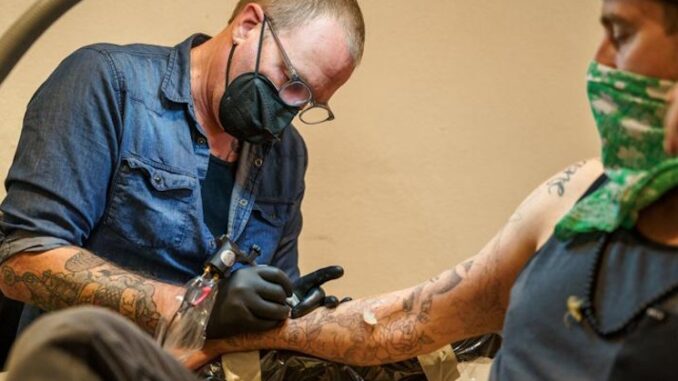
The majority of tattoo inks used in the United States are contaminated with unlisted chemicals that cause serious health issues, including organ damage, scientists have warned.
The study, published in the Analytical Chemistry journal in Feburary, investigated nine different brands of tattoo ink sold in the United States, from minor to major brands.

BYPASS THE CENSORS
Sign up to get unfiltered news delivered straight to your inbox.
You can unsubscribe any time. By subscribing you agree to our Terms of Use
Latest Video
Out of the 54 inks of the nine brands analyzed by researchers, 45 (83 percent) were found to contain “unlisted additives and/or pigments” linked to organ failure.
Zerohedge.com reports: “Major, unlisted adulterants include polyethylene glycol, propylene glycol, and higher alkanes. Many of the adulterants pose possible allergic or other health risks.”
Over half of the inks contained unlisted polyethylene glycol, which causes organ damages following repeated exposure. Fifteen inks contained propylene glycol, a potential allergen. Some contained a compound called 2-phenoxyethanol that posed health risks to nursing infants while other inks were contaminated with an antibiotic used to treat urinary tract infections.
“Taken together, the results from this study highlight the potential for a significant issue around inaccurate tattoo ink labeling in the United States,” the study stated.
The research was unable to identify whether unlisted ingredients were added unintentionally or whether the manufacturer was provided with contaminated materials. It is also unknown whether the manufacturer incorrectly labeled the inks.
Risks associated with tattooing usually focus on skin cancer and reaction to the pigments. However, ink additives can be dangerous as well, including having negative impacts beyond the skin. If a person with a tattoo starts experiencing reactions, unlisted ingredients can make it challenging to ascertain what reaction is happening and why it is occurring.
“We’re hoping the manufacturers take this as an opportunity to reevaluate their processes, and that artists and clients take this as an opportunity to push for better labeling and manufacturing,” said John Swierk, an assistant professor of chemistry at Binghamton University who is also an author of the study.
Tatto Ink Regulation
It was only recently that regulation on tattoo ink was introduced in the United States. In late 2022, Congress passed the Modernization of Cosmetics Regulation Act (MoCRA), allowing the U.S. Food and Drug Administration (FDA) to regulate tattoo inks for the first time, including regulating labeling practices.
Before the Act was passed, tattoo inks were considered to be cosmetic and not subject to regulations. “The FDA is still figuring out what that is going to look like and we think this study will influence the discussions around MoCRA,” Mr. Swierk stated.
“This is also the first study to explicitly look at inks sold in the United States and is probably the most comprehensive because it looks at the pigments, which nominally stay in the skin, and the carrier package, which is what the pigment is suspended in.”
The study only focused on substances present in quantities of 2,000 parts per million (ppm) or more, which are usually considered to be high concentrations.
However, in Europe, even substances in the range of just two ppm are considered by authorities when assessing risks. As such, the tattoo inks could contain even more potentially toxic substances than what the study has found.
Tattoo Ink Risks
A 2021 study on tattoo inks conducted in the European Union arrived at similar conclusions. It analyzed 73 tattoo inks in the market, investigating labels as well as ingredients.
The study found that “ninety-three percent of the bought tattoo inks violated European, legal requirements on labeling.”
“Fifty percent of the tattoo inks declared at least one pigment ingredient incorrectly,” authors wrote. “Sixty-one percent of the inks contained pigments of concern, especially red inks.”
Main metals detected in the inks included iron, aluminum, titanium, and copper, most of which were in green or blue inks. “The levels of iron, chromium, manganese, cobalt, nickel, zinc, lead, and arsenic were found to covary significantly.”
Researchers of the study called on tattoo ink manufacturers to follow regulations and minimize the presence of nickel and chromium impurities to prevent allergy and toxic reactions among users.
A December 2016 retrospective study looked at 493 health complications resulting from tattooing among 405 individuals. They identified 184 cases of allergic reactions, 53 instances of bacterial infections, and 46 psycho-social complications.
The U.S. Food and Drug Administration (FDA) has asked people to “think before you ink.” Multiple research studies have “reported that some inks contain pigments used in printer toner or in car paint,“ the agency stated, adding that it ”has not approved any pigments for injection into the skin for cosmetic purposes.”
After receiving a tattoo, the person may see some redness, swelling, or warmth on the skin. If the tattooed area does not heal or if there is a rash forming in the region, the FDA advises people to contact their healthcare professional. This is especially true if they develop a fever.
“More aggressive infections may cause high fever, shaking, chills, and sweats. Treating such infections might require a variety of antibiotics—possibly for months—or even hospitalization and/or surgery. A rash may also mean you’re having an allergic reaction. And because the inks are permanent, the reaction may persist,” the FDA warned.
“Scar tissue may form when you get a tattoo, or you could develop ‘granulomas,’ small knots or bumps that may form around material that the body perceives as foreign. If you tend to get keloids—scars that grow beyond normal boundaries—you may develop the same kind of reaction to the tattoo.”


